30 Fermented Food Recipes
Fermented foods are gaining popularity for their unique flavors and significant health benefits. Incorporating them into your breakfast can be a delicious and nutritious way to start your day. This article provides 10 creative and easy-to-make breakfast recipes featuring a variety of fermented foods, from the familiar yogurt and sourdough to the more adventurous kimchi and tempeh.
The Power of Fermented Foods
Fermentation is an ancient technique of preserving food. It involves the breakdown of carbohydrates by bacteria and yeast, resulting in the creation of beneficial enzymes, B-vitamins, Omega-3 fatty acids, and various strains of probiotics. These probiotics are live microorganisms that can provide health benefits when consumed, improving gut health, boosting the immune system, and even aiding in weight management. [1]
Naturally fermented foods are getting a lot of attention from health experts these days because they may help strengthen your gut microbiome. [2]
By adding fermented foods to your breakfast, you are not only enhancing the flavor of your meal but also giving your body a healthy dose of probiotics to kickstart your day.
Now, let’s dive into the recipes!
1. Kefir Smoothie Bowl
Kefir is a fermented milk drink with a tart, slightly effervescent flavor. It’s packed with probiotics and is a fantastic base for a smoothie bowl.
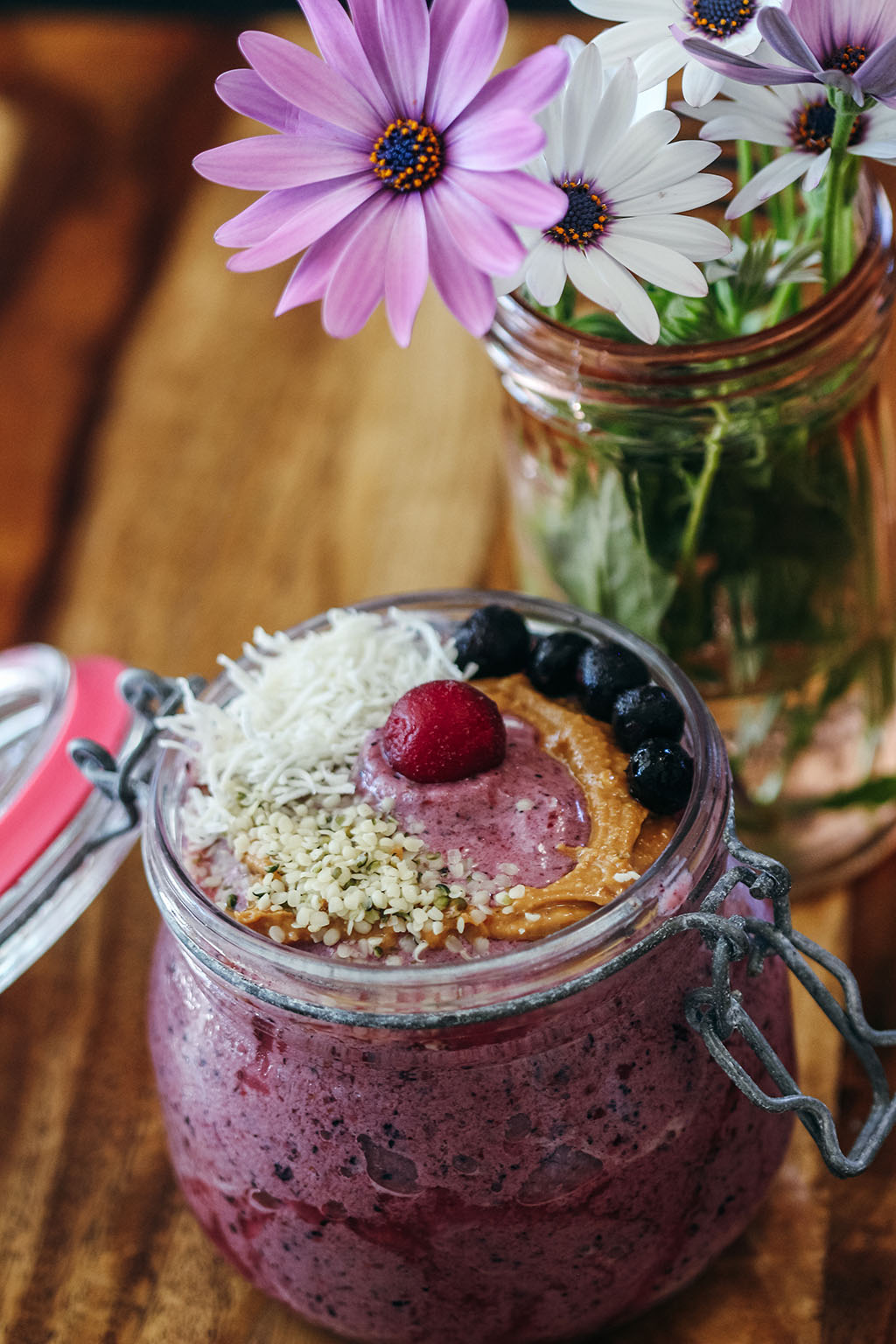
Ingredients:
- 1 cup plain kefir
- 1/2 cup frozen mixed berries
- 1/2 frozen banana
- 1 tablespoon chia seeds
- Toppings: granola, fresh fruit, nuts, seeds
Instructions:
- In a blender, combine the kefir, frozen berries, frozen banana, and chia seeds.
- Blend until smooth and creamy.
- Pour the smoothie into a bowl.
- Top with your favorite granola, fresh fruit, nuts, and seeds.
This recipe is a great way to get a dose of probiotics, fiber, and vitamins to start your day. [3]
2. Sourdough Pancakes
Sourdough pancakes are a delicious way to use up your sourdough starter discard. The fermentation process gives them a unique, slightly tangy flavor and makes them easier to digest.

Ingredients:
- 1 cup sourdough starter
- 1 cup all-purpose flour
- 1 tablespoon sugar
- 1 teaspoon baking powder
- 1/2 teaspoon baking soda
- 1/2 teaspoon salt
- 1 egg
- 3/4 cup milk
- 2 tablespoons melted butter
Instructions:
- In a large bowl, whisk together the sourdough starter, flour, sugar, baking powder, baking soda, and salt.
- In a separate bowl, whisk together the egg, milk, and melted butter.
- Pour the wet ingredients into the dry ingredients and stir until just combined. Do not overmix.
- Heat a lightly oiled griddle or frying pan over medium-high heat.
- Pour or scoop the batter onto the griddle, using approximately 1/4 cup for each pancake.
- Cook for 2-3 minutes per side, or until golden brown and cooked through.
- Serve with your favorite toppings, such as maple syrup, fresh fruit, or a dollop of yogurt. [4]
3. Kimchi Scrambled Eggs
Kimchi, a staple in Korean cuisine, is a traditional side dish of salted and fermented vegetables, such as napa cabbage and Korean radish. Adding it to scrambled eggs gives them a spicy, tangy kick.
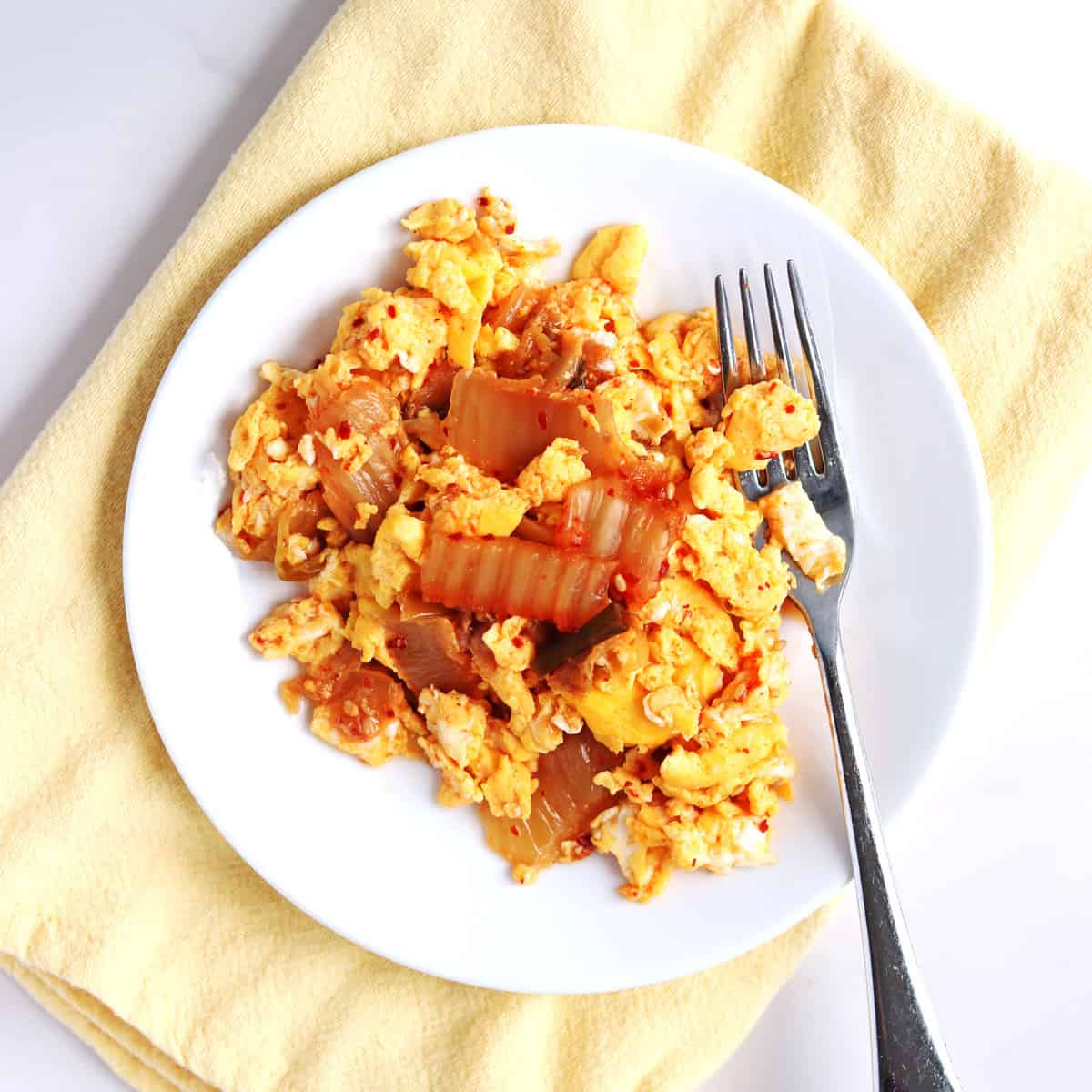
Ingredients:
- 2 eggs
- 1/4 cup chopped kimchi
- 1 teaspoon sesame oil
- Salt and pepper to taste
- Optional: chopped scallions for garnish
Instructions:
- In a small bowl, whisk the eggs with a pinch of salt and pepper.
- Heat the sesame oil in a non-stick skillet over medium heat.
- Add the chopped kimchi and cook for 1-2 minutes, until fragrant.
- Pour the whisked eggs into the skillet with the kimchi.
- Cook, stirring gently, until the eggs are cooked to your liking.
- Garnish with chopped scallions and serve immediately. [5]
4. Miso Soup
A traditional Japanese breakfast often includes a warm bowl of miso soup. Miso is a fermented soybean paste that is rich in essential minerals and a good source of various B vitamins, vitamins E, K and folic acid.
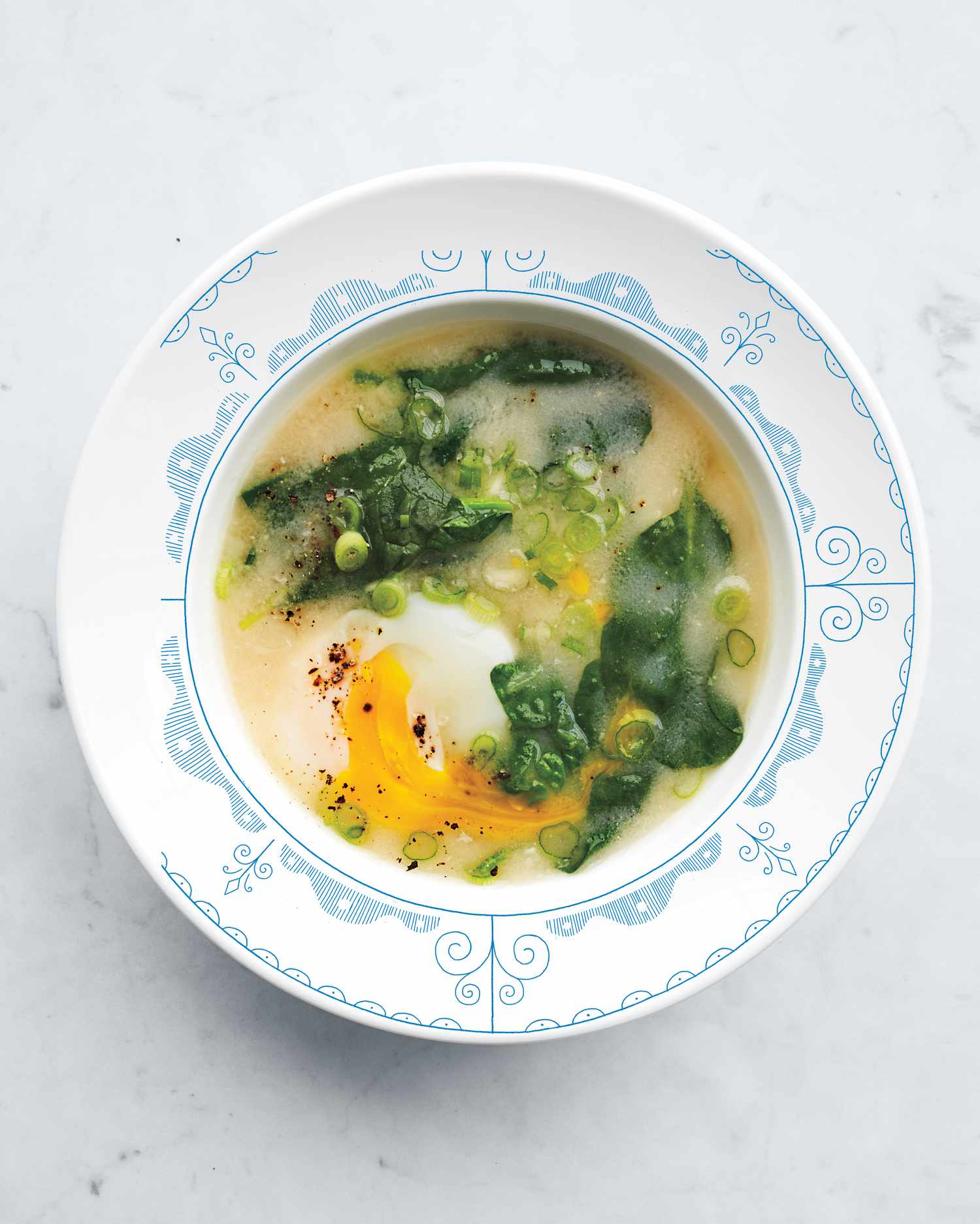
Ingredients:
- 4 cups dashi (Japanese soup stock)
- 3-4 tablespoons miso paste
- 1/2 cup soft tofu, cubed
- 2 tablespoons chopped green onions
- 1 tablespoon wakame seaweed (rehydrated)
Instructions:
- In a medium saucepan, bring the dashi to a simmer.
- In a small bowl, whisk the miso paste with a small amount of the hot dashi until smooth. This prevents the miso from clumping.
- Add the dissolved miso to the saucepan and stir gently.
- Add the tofu and wakame seaweed and heat through. Do not boil the soup after adding the miso, as this can destroy the probiotics.
- Serve hot, garnished with chopped green onions. [6]
5. Tempeh Breakfast Scramble
Tempeh is a traditional Indonesian food made from fermented soybeans. It’s a great source of protein and has a nutty, mushroom-like flavor. A tempeh scramble is a hearty and satisfying vegan breakfast.
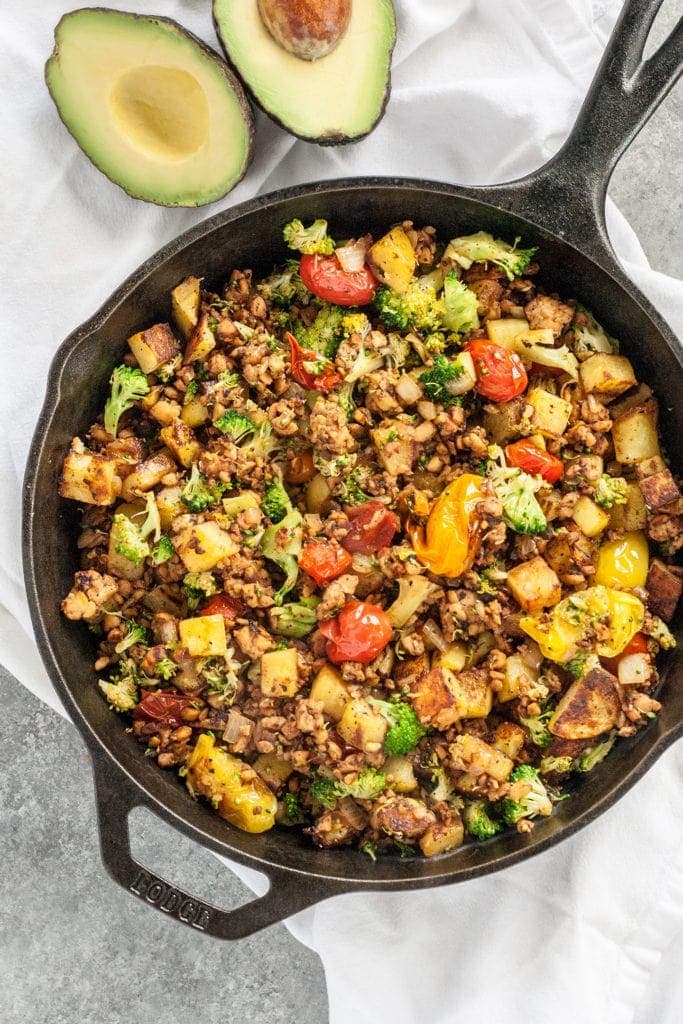
Ingredients:
- 8 oz tempeh, crumbled
- 1 tablespoon olive oil
- 1/2 onion, chopped
- 1 bell pepper, chopped
- 1 teaspoon turmeric powder
- 1/2 teaspoon cumin powder
- Salt and pepper to taste
- Optional: 1/4 cup nutritional yeast for a cheesy flavor
Instructions:
- Steam the tempeh for 10 minutes to soften it.
- Heat the olive oil in a large skillet over medium heat.
- Add the onion and bell pepper and cook until softened.
- Add the crumbled tempeh, turmeric, and cumin to the skillet. Cook for 5-7 minutes, until the tempeh is lightly browned.
- Stir in the nutritional yeast (if using) and season with salt and pepper.
- Serve hot with a side of toast or avocado. [7]
6. Sauerkraut Breakfast Hash
Sauerkraut, or fermented cabbage, is a probiotic powerhouse. This breakfast hash combines the tangy flavor of sauerkraut with potatoes and eggs for a hearty and flavorful meal.
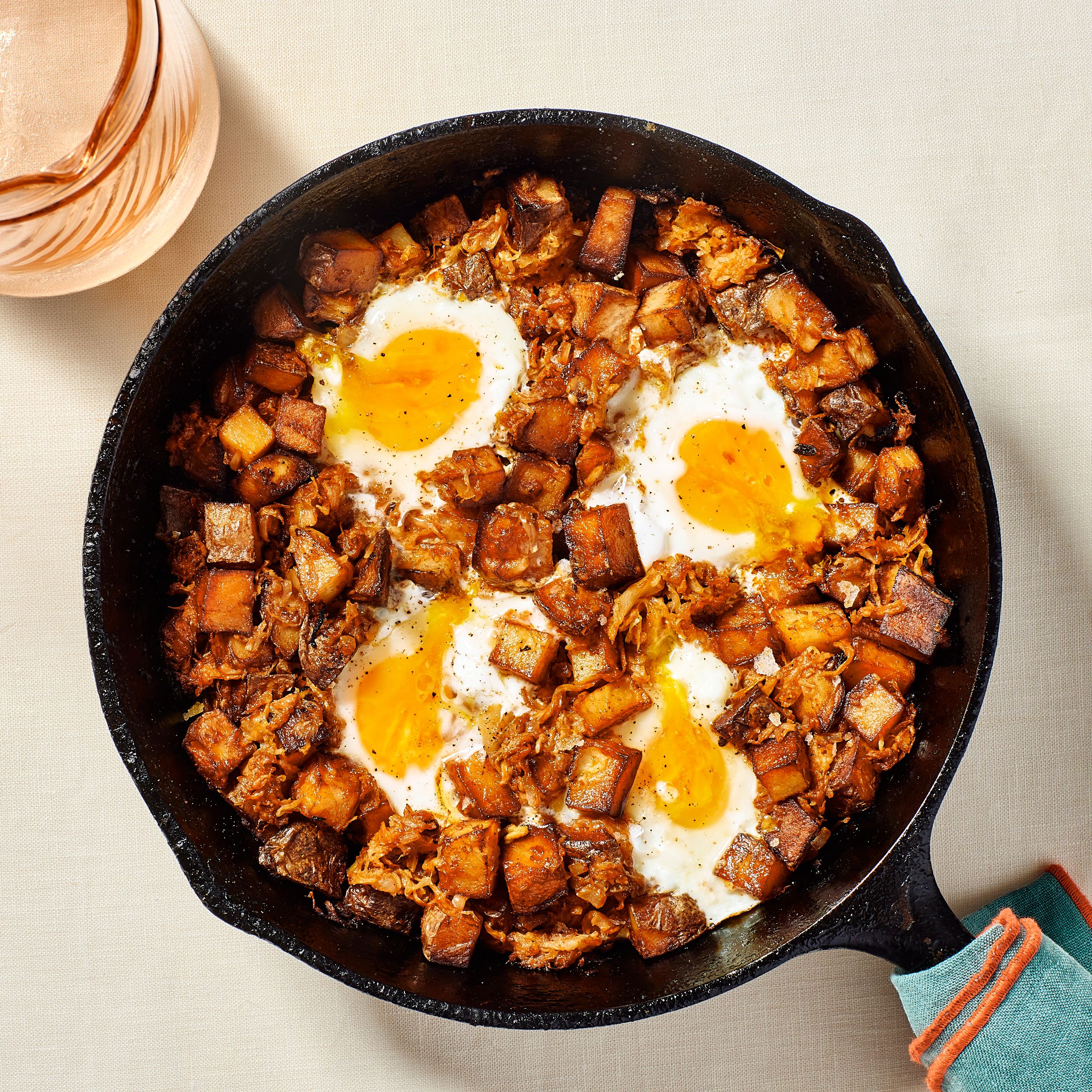
Ingredients:
- 2 cups diced potatoes
- 1 tablespoon olive oil
- 1/2 cup chopped onions
- 1/2 cup sauerkraut, drained
- 2 eggs
- Salt and pepper to taste
Instructions:
- Boil or steam the diced potatoes until tender. Drain and set aside.
- Heat the olive oil in a large skillet over medium heat.
- Add the onions and cook until softened.
- Add the cooked potatoes to the skillet and cook until lightly browned and crispy.
- Stir in the sauerkraut and cook for another 2-3 minutes.
- Create two wells in the hash and crack an egg into each well.
- Cook until the egg whites are set and the yolks are cooked to your liking.
- Season with salt and pepper and serve immediately. [8]
7. Fermented Overnight Oats
Fermenting your oats overnight not only enhances their nutritional value but also gives them a pleasant, tangy flavor. This is a great make-ahead breakfast for busy mornings.
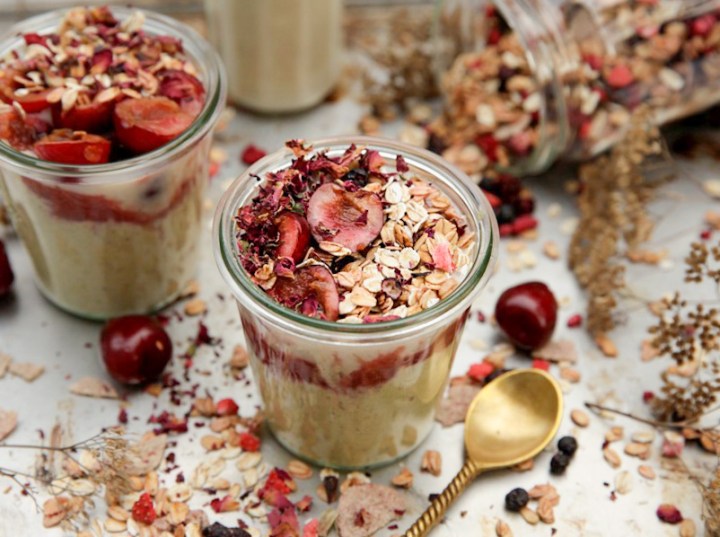
Ingredients:
- 1/2 cup rolled oats
- 1/2 cup water or milk
- 1 tablespoon yogurt or kefir (as a starter culture)
- 1 tablespoon chia seeds
- Sweetener of your choice (maple syrup, honey, etc.)
- Toppings: fresh fruit, nuts, seeds
Instructions:
- In a jar or bowl, combine the oats, water or milk, yogurt or kefir, and chia seeds.
- Stir well to combine.
- Cover the jar or bowl and let it sit at room temperature for 8-12 hours, or overnight.
- In the morning, stir in your favorite sweetener and top with fresh fruit, nuts, and seeds.
- You can also store the fermented oats in the refrigerator for a cooler breakfast. [9]
8. Kombucha Smoothie
Kombucha is a fermented tea that is bubbly, tart, and slightly sweet. It’s a great alternative to sugary sodas and can be used as a base for a refreshing and probiotic-rich smoothie.
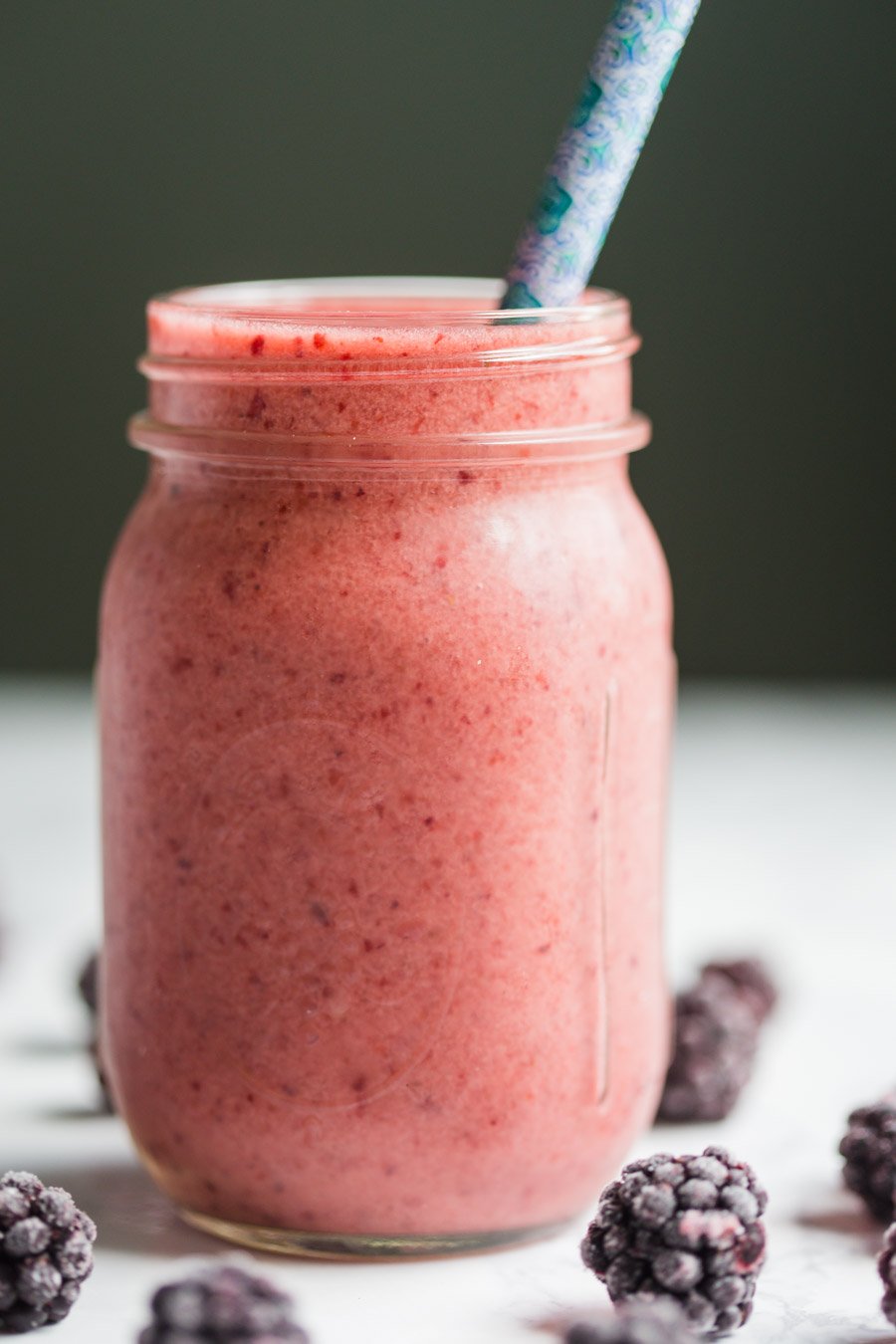
Ingredients:
- 1 cup kombucha (any flavor)
- 1/2 cup frozen fruit (mango, pineapple, etc.)
- 1/2 banana
- 1/4 cup yogurt or kefir
Instructions:
- In a blender, combine the kombucha, frozen fruit, banana, and yogurt or kefir.
- Blend until smooth and creamy.
- Pour into a glass and enjoy immediately. [10]
9. Fermented Buckwheat Pancakes
Buckwheat is a gluten-free pseudocereal that is rich in nutrients. Fermenting the batter for these pancakes makes them light, fluffy, and easy to digest.
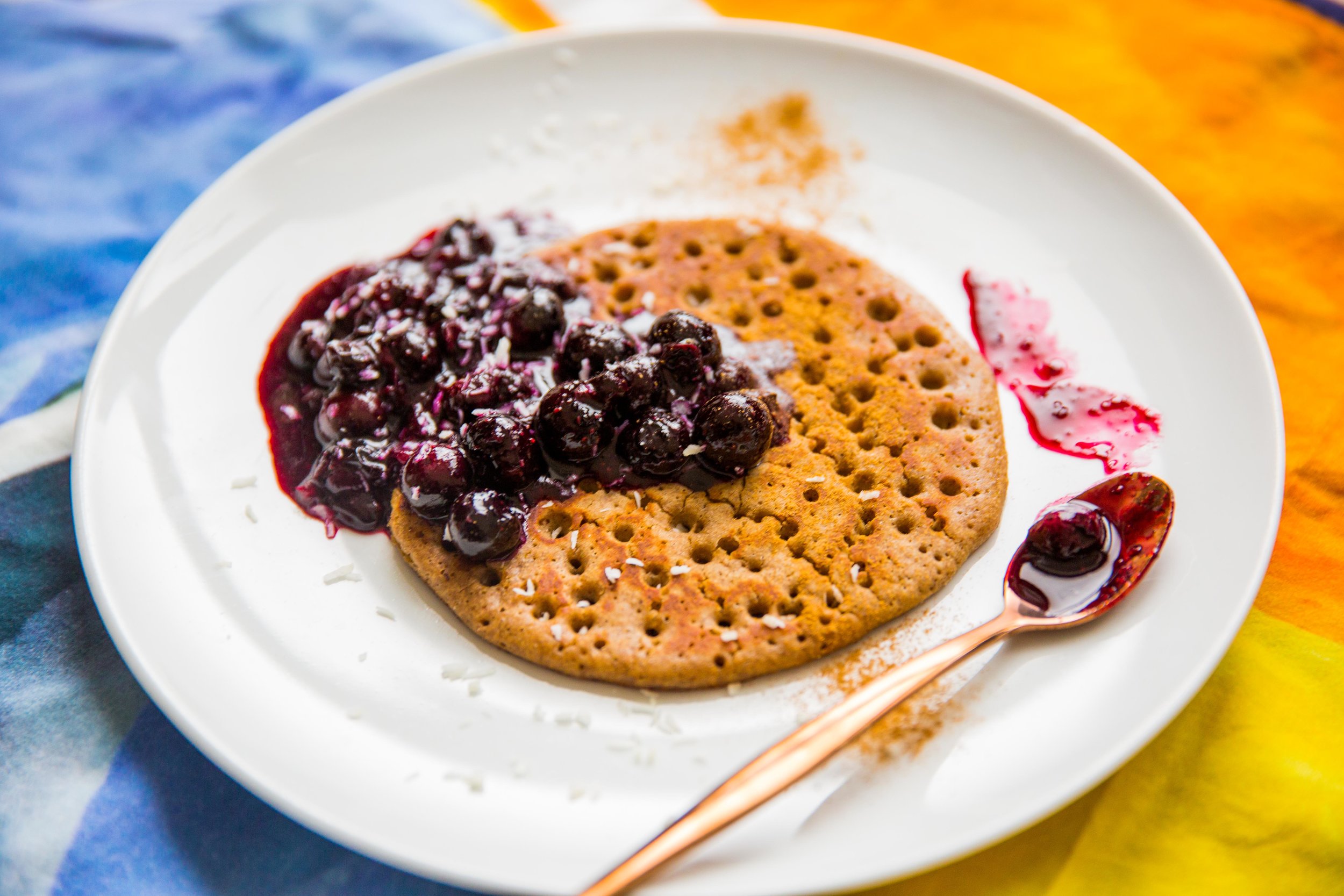
Ingredients:
- 1 cup buckwheat groats, soaked overnight
- 1/2 cup water
- 1 tablespoon maple syrup
- 1/2 teaspoon baking soda
- Pinch of salt
Instructions:
- Drain and rinse the soaked buckwheat groats.
- In a blender, combine the buckwheat groats, water, and maple syrup. Blend until smooth.
- Pour the batter into a bowl, cover, and let it ferment at room temperature for 12-24 hours.
- When ready to cook, stir in the baking soda and salt.
- Heat a lightly oiled griddle or frying pan over medium heat.
- Pour the batter onto the griddle to form pancakes.
- Cook for 2-3 minutes per side, until golden brown.
- Serve with your favorite toppings. [11]
10. Pickled Vegetable Breakfast Bowl
Pickled vegetables are a great way to add a tangy and crunchy element to your breakfast bowl. You can use any combination of pickled vegetables you like, such as carrots, cucumbers, or radishes.
Ingredients:
- 1/2 cup cooked quinoa or brown rice
- 1/4 cup mixed pickled vegetables
- 1 fried or poached egg
- 1/4 avocado, sliced
- Sesame seeds for garnish
Instructions:
- In a bowl, combine the cooked quinoa or brown rice, pickled vegetables, and sliced avocado.
- Top with a fried or poached egg.
- Garnish with sesame seeds and serve immediately. [12]
10 Fermented Food Lunch Recipes
Following up on our popular breakfast article, we now present 10 delicious and healthy lunch recipes featuring fermented foods. These recipes are perfect for a midday meal, offering a boost of probiotics and unique flavors to keep you energized throughout the afternoon.
The Benefits of a Fermented Lunch
Incorporating fermented foods into your lunch can significantly improve your digestive health and overall well-being. The probiotics in these foods help maintain a healthy gut microbiome, which is crucial for digestion, nutrient absorption, and immune function. [1]
A healthy gut is the foundation of a healthy body. By consuming a variety of fermented foods, you can increase the diversity of your gut bacteria, which is linked to numerous health benefits. [2]
From savory sandwiches to refreshing salads, these recipes will show you how easy and delicious it is to make fermented foods a regular part of your lunchtime routine.
1. Kimchi Fried Rice
Kimchi fried rice, or kimchi-bokkeumbap, is a classic Korean comfort food that is both delicious and easy to make. The fermented kimchi adds a spicy and tangy flavor that perfectly complements the rice and other ingredients.
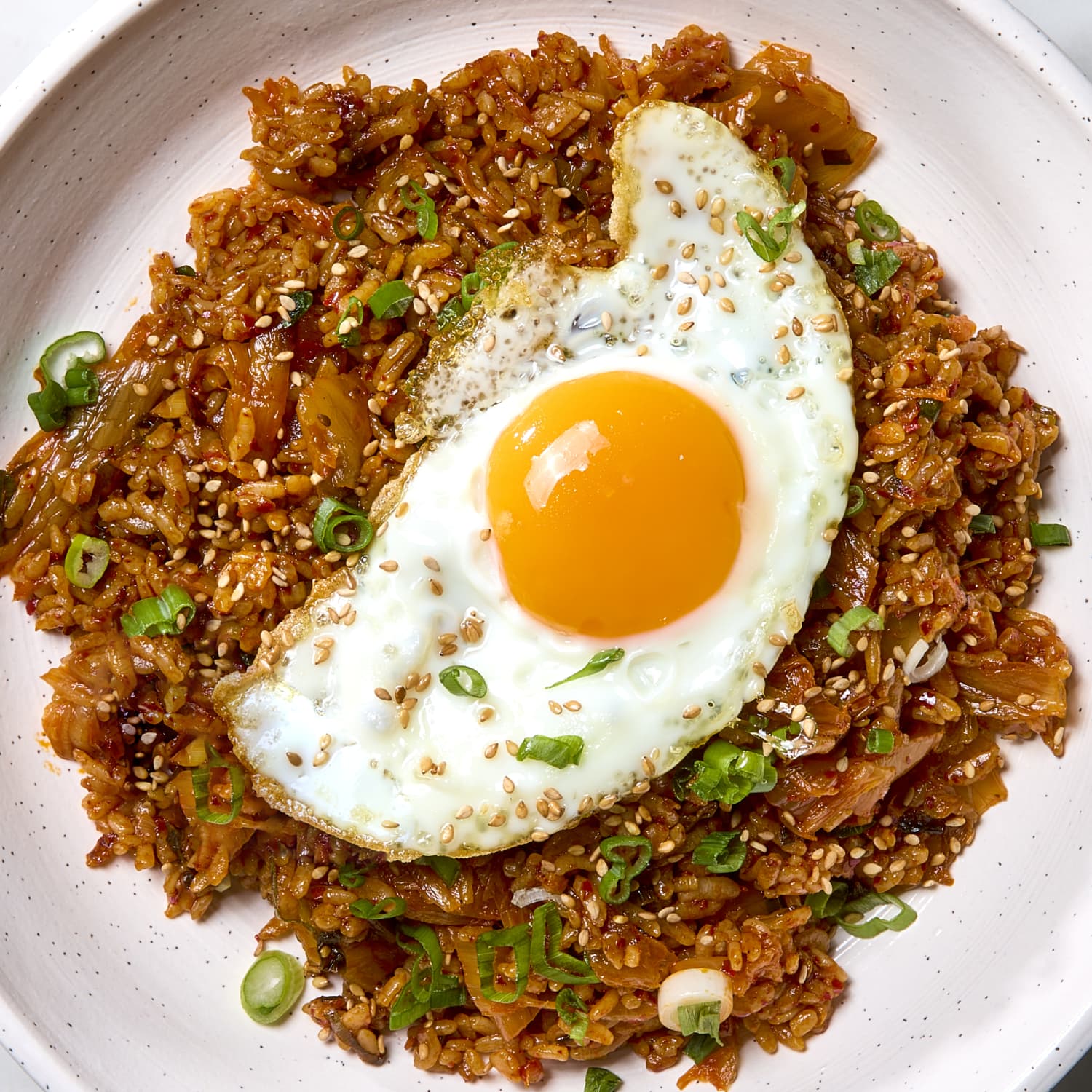
Ingredients:
- 1 cup cooked rice, preferably day-old
- 1/2 cup chopped kimchi
- 2 tablespoons kimchi juice
- 1 tablespoon gochujang (Korean chili paste)
- 1 teaspoon sesame oil
- 1 fried egg
- Optional: diced bacon or spam, chopped scallions
Instructions:
- In a large skillet or wok, heat the sesame oil over medium-high heat.
- If using, add the bacon or spam and cook until crispy.
- Add the chopped kimchi and cook for 2-3 minutes, until slightly softened.
- Stir in the cooked rice, kimchi juice, and gochujang. Break up any clumps of rice and stir-fry for 3-5 minutes, until the rice is heated through and well combined.
- Transfer the kimchi fried rice to a bowl and top with a fried egg and chopped scallions.
This dish is a great way to use up leftover rice and kimchi, and it comes together in under 20 minutes. [3]
2. Tempeh Buddha Bowl
A Buddha bowl is a versatile and nutritious meal that can be customized with your favorite ingredients. This version features marinated tempeh, a fermented soybean cake that is a great source of plant-based protein.
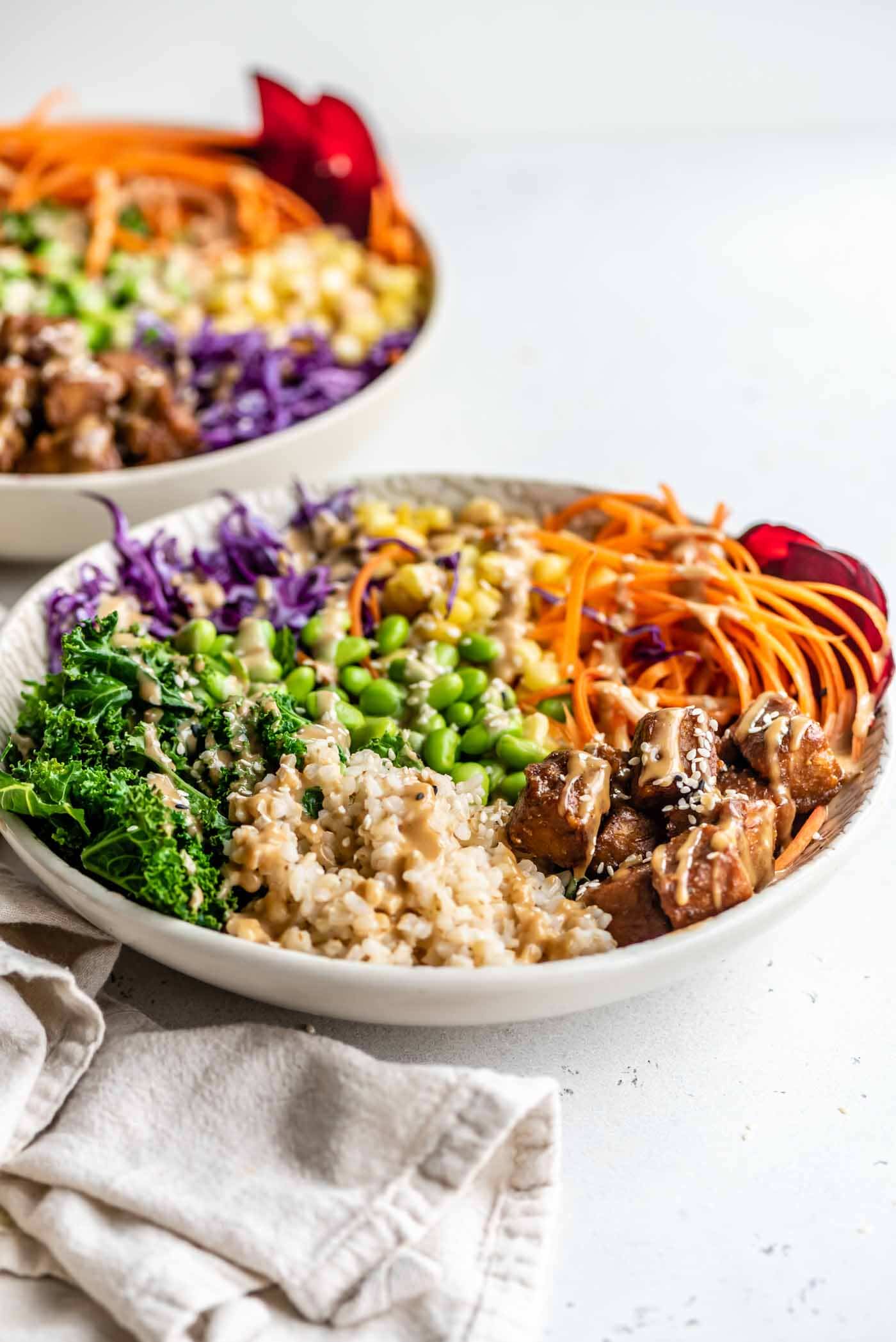
Ingredients:
- 1 block (8 oz) tempeh, cubed
- 2 tablespoons soy sauce or tamari
- 1 tablespoon maple syrup
- 1 tablespoon rice vinegar
- 1 cup cooked quinoa or brown rice
- 2 cups mixed greens
- 1 cup chopped vegetables (e.g., carrots, cucumbers, bell peppers)
- Tahini dressing
Instructions:
- In a shallow dish, whisk together the soy sauce, maple syrup, and rice vinegar.
- Add the cubed tempeh and marinate for at least 30 minutes.
- While the tempeh is marinating, prepare the rest of the bowl ingredients.
- Heat a skillet over medium-high heat and cook the marinated tempeh for 5-7 minutes, until golden brown and heated through.
- Assemble the Buddha bowl by starting with a base of mixed greens and quinoa. Top with the cooked tempeh, chopped vegetables, and a drizzle of tahini dressing.
This colorful and satisfying bowl is packed with protein, fiber, and probiotics. [4]
3. Classic Reuben Sandwich
The Reuben sandwich is a deli classic for a reason. The combination of corned beef, Swiss cheese, sauerkraut, and Russian dressing on rye bread is simply irresistible. The sauerkraut, or fermented cabbage, provides a tangy crunch that cuts through the richness of the other ingredients.

Ingredients:
- 2 slices rye bread
- 4 oz sliced corned beef
- 2 slices Swiss cheese
- 1/4 cup sauerkraut, drained
- 2 tablespoons Russian or Thousand Island dressing
- Butter
Instructions:
- Spread butter on one side of each slice of rye bread.
- Place one slice of bread, butter-side down, in a skillet over medium heat.
- Layer with one slice of Swiss cheese, the corned beef, sauerkraut, and the second slice of Swiss cheese.
- Spread the dressing on the remaining slice of bread and place it on top, butter-side up.
- Grill the sandwich for 5-7 minutes per side, until the bread is golden brown and the cheese is melted.
This hearty sandwich is a perfect lunch for a cold day. [5]
4. Miso Noodle Soup
Miso noodle soup is a light and comforting lunch that is packed with flavor and nutrients. The miso paste, made from fermented soybeans, provides a rich umami flavor and a dose of probiotics.
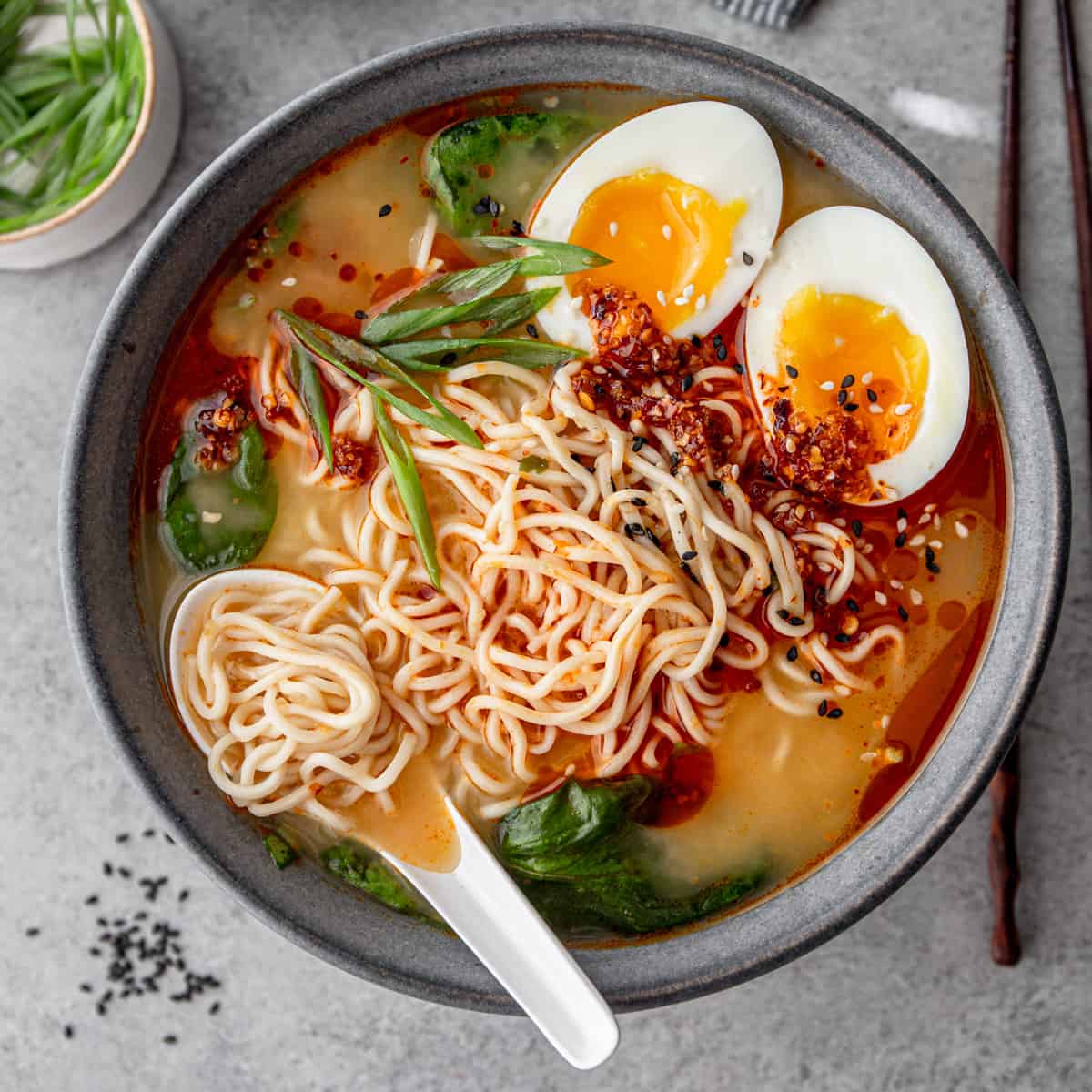
Ingredients:
- 4 cups vegetable or chicken broth
- 3 tablespoons miso paste
- 2 bundles of ramen or udon noodles
- 1 cup sliced mushrooms
- 1 cup spinach
- Optional: soft-boiled egg, sliced scallions, nori
Instructions:
- In a large pot, bring the broth to a simmer.
- Cook the noodles according to package directions. Drain and set aside.
- In a small bowl, whisk the miso paste with a little bit of the hot broth until smooth.
- Add the miso mixture to the pot and stir to combine. Do not let the soup boil after adding the miso.
- Add the mushrooms and spinach and cook until the mushrooms are tender and the spinach is wilted.
- Divide the cooked noodles among two bowls and ladle the miso soup over the top.
- Garnish with a soft-boiled egg, sliced scallions, and nori, if desired.
This quick and easy soup is a perfect way to warm up on a chilly day. [6]
5. Fermented Vegetable Salad
A salad made with fermented vegetables is a refreshing and probiotic-rich lunch. You can use any combination of fermented vegetables you like, such as carrots, beets, or cabbage.
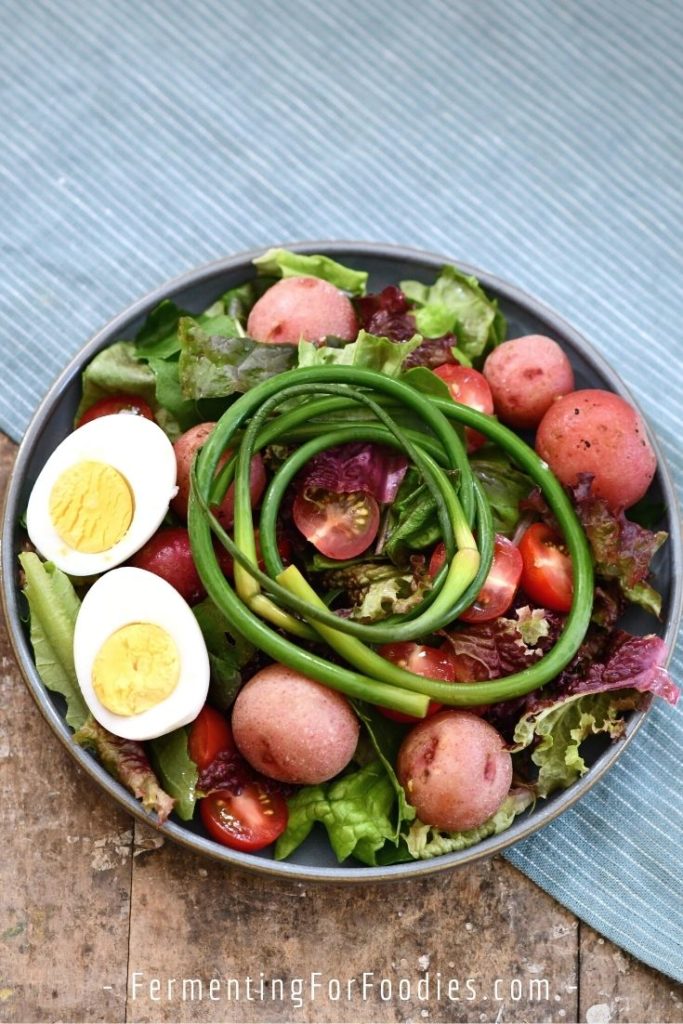
Ingredients:
- 2 cups mixed fermented vegetables
- 1 cup chopped cucumber
- 1/2 cup chopped red onion
- 1/4 cup chopped fresh dill
- 2 tablespoons olive oil
Instructions:
- In a large bowl, combine the fermented vegetables, cucumber, red onion, and dill.
- Drizzle with olive oil and toss to combine.
- Serve immediately for a crunchy and tangy salad.
This simple salad is a great way to get a variety of probiotics and nutrients. [7]
6. Fermented Hummus and Veggie Wrap
Fermented hummus is a probiotic-rich twist on the classic dip. It’s made by adding a starter culture, such as yogurt or kefir, to traditional hummus and allowing it to ferment for a day or two. The result is a tangy and extra-creamy hummus that is perfect for a veggie wrap.
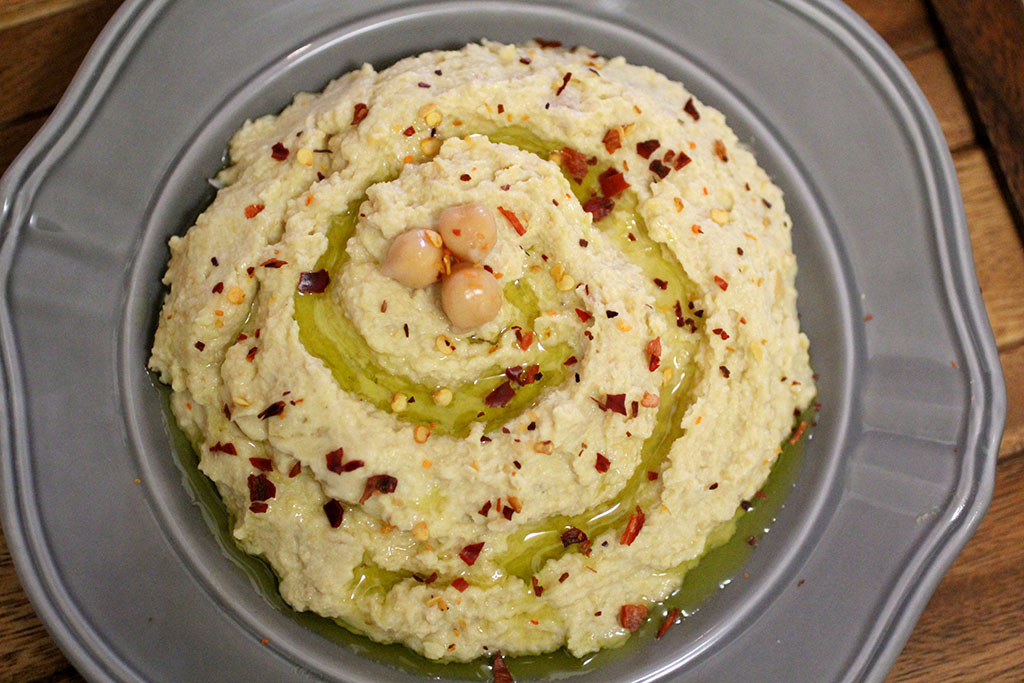
Ingredients:
- 1/4 cup fermented hummus
- 1 large whole-wheat tortilla
- 1/2 cup mixed greens
- 1/4 cup shredded carrots
- 1/4 cup sliced cucumber
- 1/4 cup sliced bell peppers
Instructions:
- Spread the fermented hummus evenly over the tortilla.
- Layer the mixed greens, shredded carrots, sliced cucumber, and sliced bell peppers on top of the hummus.
- Roll up the tortilla tightly and slice in half.
This quick and easy wrap is a great way to pack in a variety of vegetables and get a dose of probiotics. [8]
7. Sourdough Sandwich with Turkey and Avocado
Sourdough bread is a naturally leavened bread that is made with a fermented starter. This process gives the bread a tangy flavor and makes it easier to digest. A simple sourdough sandwich with turkey and avocado is a healthy and satisfying lunch.
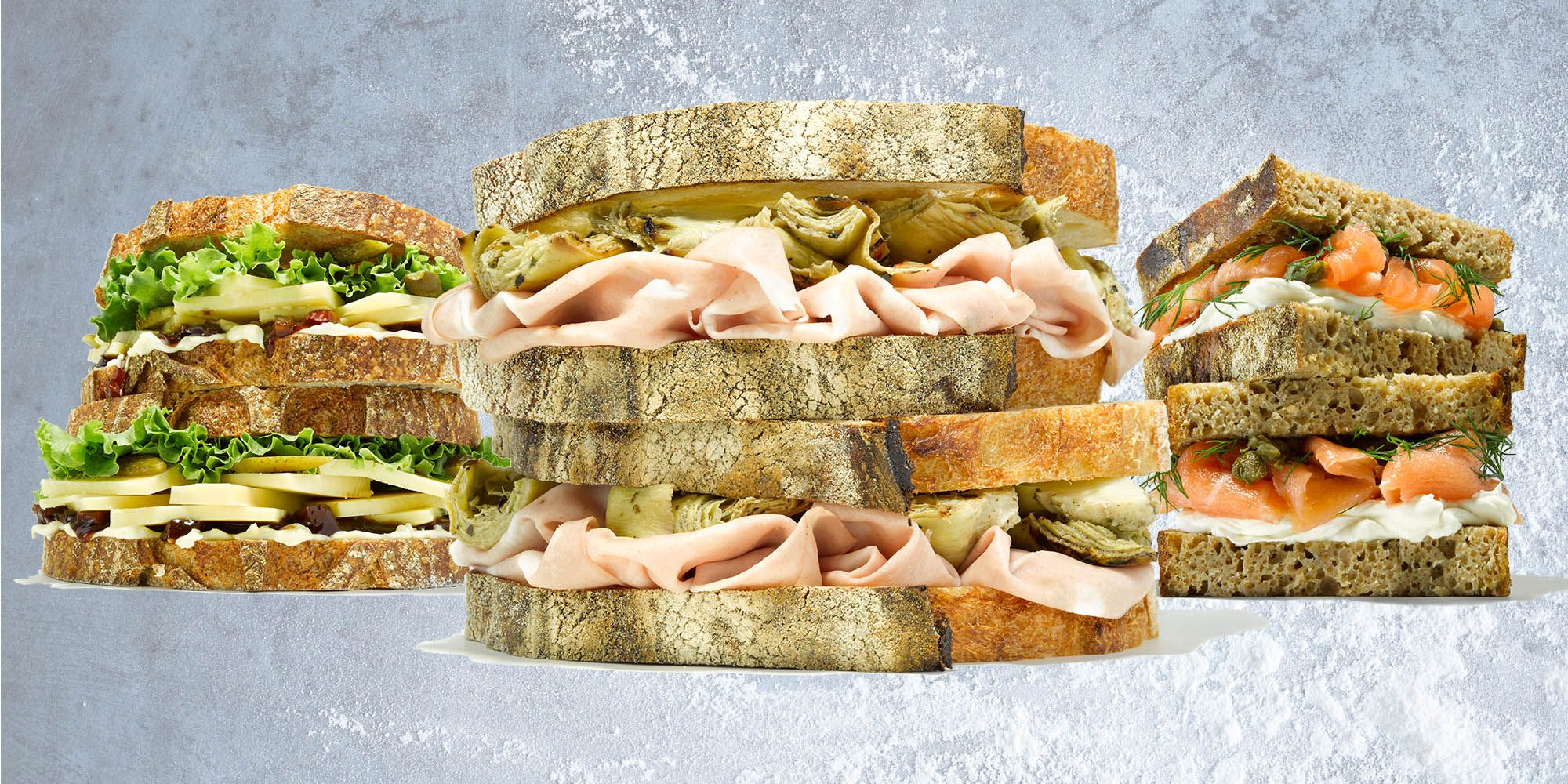
Ingredients:
- 2 slices sourdough bread
- 4 oz sliced turkey
- 1/2 avocado, sliced
- 1 tablespoon mayonnaise or mustard
- Lettuce and tomato slices
Instructions:
- Toast the sourdough bread slices to your liking.
- Spread mayonnaise or mustard on one slice of the bread.
- Layer with the turkey, avocado, lettuce, and tomato.
- Top with the other slice of bread and serve immediately.
This simple sandwich is a great way to enjoy the benefits of sourdough bread. [9]
8. Salad with Kombucha Vinaigrette
Kombucha is not just for drinking! Its tangy and slightly sweet flavor makes it a great base for a salad dressing. This kombucha vinaigrette is a healthy and flavorful alternative to store-bought dressings.
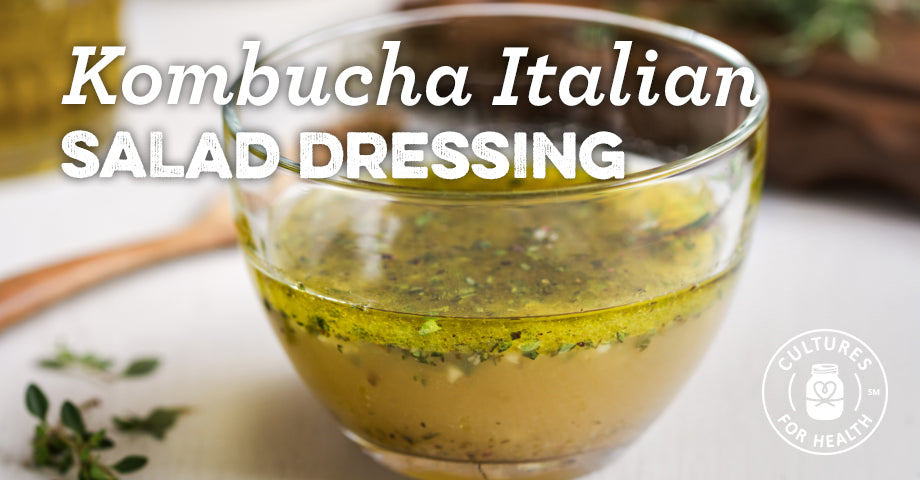
Ingredients:
- 1/4 cup kombucha (plain or ginger)
- 1/2 cup olive oil
- 1 tablespoon Dijon mustard
- 1 teaspoon honey or maple syrup
- Salt and pepper to taste
Instructions:
- In a small bowl or jar, whisk together the kombucha, olive oil, Dijon mustard, and honey or maple syrup.
- Season with salt and pepper to taste.
- Drizzle over your favorite salad greens and vegetables.
This simple vinaigrette is a great way to add a probiotic boost to your salad. [10]
9. Pickle Wrap Sandwich
This low-carb and gluten-free sandwich uses a large pickle as the “bread.” It’s a fun and crunchy way to enjoy a sandwich without the carbs. The fermented pickle provides a tangy flavor and a dose of probiotics.

Ingredients:
- 1 large dill pickle
- 2 oz sliced turkey or ham
- 1 slice provolone cheese
- 1 tablespoon cream cheese
Instructions:
- Slice the pickle in half lengthwise and scoop out the seeds.
- Spread the cream cheese on the inside of each pickle half.
- Layer the turkey or ham and provolone cheese on one half of the pickle.
- Top with the other half of the pickle and serve immediately.
This creative sandwich is a great way to satisfy your sandwich craving while getting a dose of probiotics. [11]
10. Kefir Ranch Dip with Veggie Sticks
Kefir, a fermented milk drink, can be used to make a healthy and probiotic-rich ranch dip. This dip is perfect for a light lunch or snack with a side of fresh vegetable sticks.
Ingredients:
- 1 cup plain kefir
- 1 tablespoon chopped fresh dill
- 1 tablespoon chopped fresh chives
- 1/2 teaspoon garlic powder
- 1/2 teaspoon onion powder
- Salt and pepper to taste
- Assorted vegetable sticks (carrots, celery, cucumbers, bell peppers)
Instructions:
- In a small bowl, whisk together the kefir, dill, chives, garlic powder, and onion powder.
- Season with salt and pepper to taste.
- Serve the dip with a side of assorted vegetable sticks for a healthy and refreshing lunch.
This creamy and tangy dip is a great way to get a dose of probiotics and enjoy your vegetables. [12]
10 Fermented Food Dinner Recipes
To complete our series on fermented food recipes, we present 10 delicious and satisfying dinner ideas. These recipes showcase the versatility of fermented ingredients, from hearty stews to flavorful stir-fries, providing a nutritious and probiotic-rich end to your day.
A Fermented Feast for Dinner
Incorporating fermented foods into your dinner is a fantastic way to support your digestive health while enjoying complex and exciting flavors. The fermentation process not only preserves food but also creates beneficial probiotics and enzymes that can improve gut health, boost immunity, and enhance nutrient absorption. [1]
“The art of fermentation is a culinary tradition that has been practiced for centuries across the globe. By embracing these ancient techniques, we can unlock a world of flavor and nutrition.” [2]
These dinner recipes will inspire you to explore the world of fermented foods and create delicious and healthy meals for you and your family.
1. Kimchi Jjigae (Kimchi Stew)
Kimchi jjigae is a classic Korean stew that is both comforting and flavorful. The star of the dish is aged, sour kimchi, which gives the stew its characteristic spicy and tangy taste.
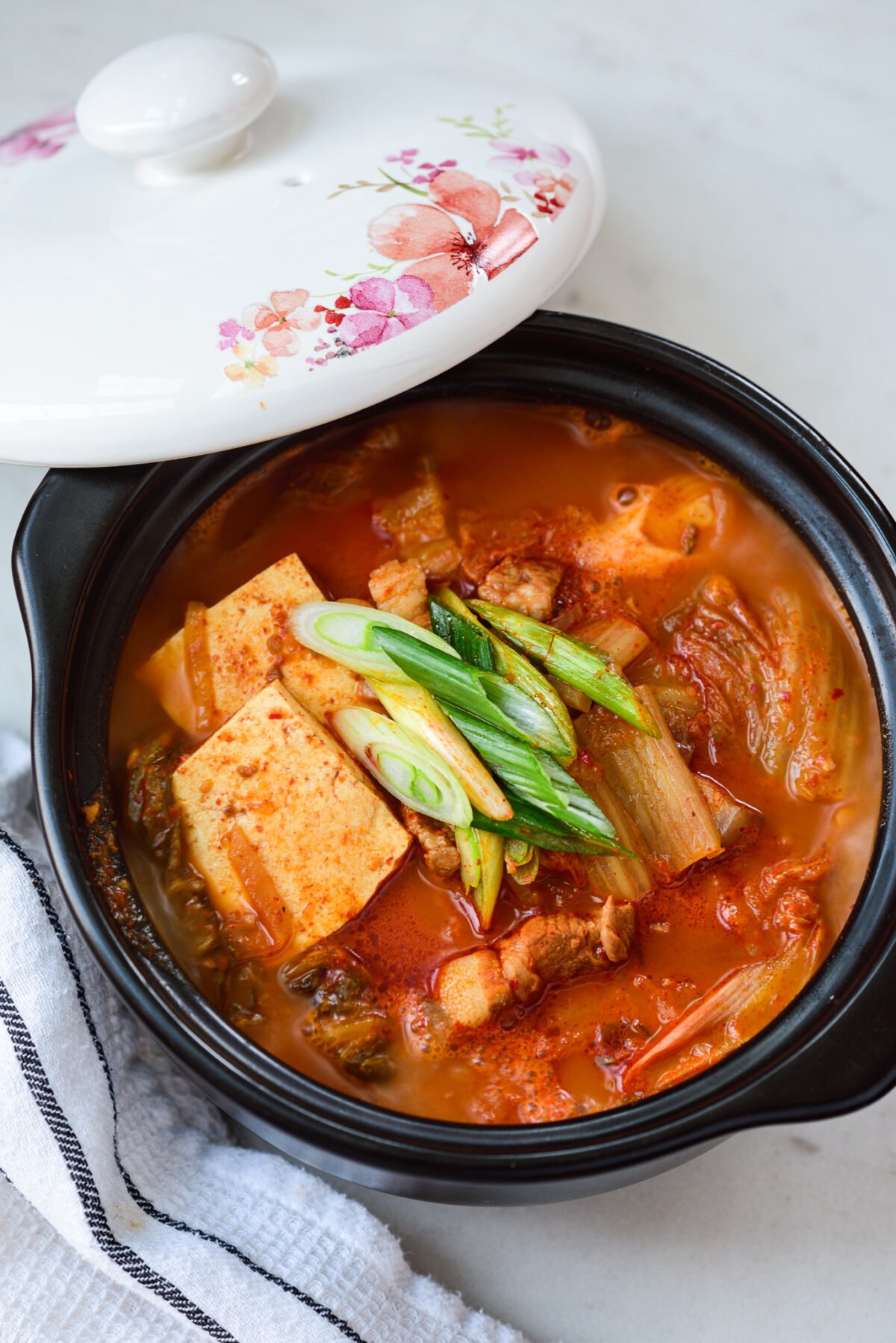
Ingredients:
- 1 lb pork shoulder or belly, cut into bite-sized pieces
- 1 lb aged kimchi, chopped
- 1/2 cup kimchi juice
- 4 cups water or anchovy broth
- 1/2 block tofu, sliced
- 1 onion, sliced
- 2 scallions, chopped
- 1 tablespoon gochujang (Korean chili paste)
- 1 tablespoon gochugaru (Korean chili flakes)
- 1 teaspoon sesame oil
Instructions:
- In a large pot, brown the pork pieces over medium-high heat.
- Add the chopped kimchi and cook for 5-7 minutes, until the kimchi is softened and fragrant.
- Stir in the kimchi juice, water or broth, gochujang, and gochugaru. Bring to a boil, then reduce the heat and simmer for 20-30 minutes, until the pork is tender.
- Add the sliced tofu and onion and cook for another 5-10 minutes, until the onion is translucent.
- Stir in the chopped scallions and sesame oil before serving.
This hearty stew is perfect for a cold evening and is a great way to use up a large batch of kimchi. [3]
2. Miso Glazed Salmon
Miso glazed salmon is a quick and elegant dinner that is packed with flavor. The sweet and savory miso glaze caramelizes on the salmon as it cooks, creating a delicious and healthy meal.

Ingredients:
- 4 (6 oz) salmon fillets
- 1/4 cup white miso paste
- 2 tablespoons mirin (sweet Japanese rice wine)
- 1 tablespoon soy sauce
- 1 tablespoon honey or maple syrup
- 1 teaspoon grated ginger
Instructions:
- Preheat your broiler to high.
- In a small bowl, whisk together the miso paste, mirin, soy sauce, honey or maple syrup, and grated ginger.
- Place the salmon fillets on a baking sheet lined with parchment paper.
- Brush the miso glaze over the salmon fillets, making sure to coat them evenly.
- Broil the salmon for 5-7 minutes, or until the glaze is bubbly and caramelized and the salmon is cooked through.
- Serve with a side of steamed rice and vegetables.
This simple and flavorful dish is a great way to incorporate the benefits of miso into your dinner routine. [4]
3. Tempeh Stir-Fry
Tempeh stir-fry is a quick and healthy dinner that is perfect for a busy weeknight. The tempeh, a fermented soybean cake, absorbs the flavors of the stir-fry sauce, creating a delicious and satisfying meal.
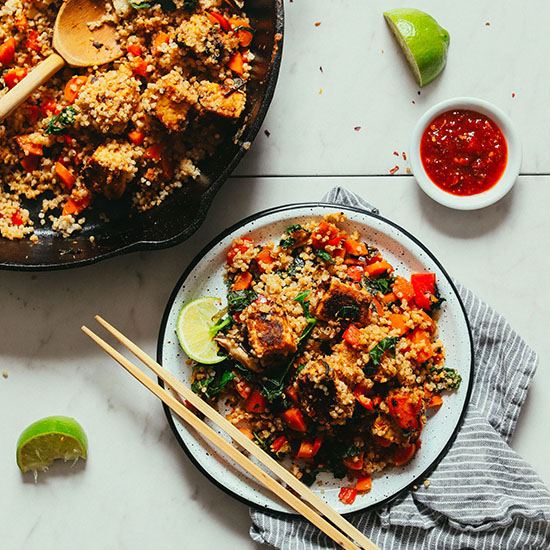
Ingredients:
- 1 block (8 oz) tempeh, cubed
- 1 tablespoon sesame oil
- 1 onion, sliced
- 2 cloves garlic, minced
- 1 head of broccoli, cut into florets
- 1 bell pepper, sliced
- 1/4 cup soy sauce or tamari
- 2 tablespoons rice vinegar
- 1 tablespoon maple syrup
- Cooked rice or noodles for serving
Instructions:
- Steam the tempeh for 10 minutes to soften it.
- In a large skillet or wok, heat the sesame oil over medium-high heat.
- Add the onion and garlic and cook until fragrant.
- Add the tempeh and cook for 5-7 minutes, until lightly browned.
- Add the broccoli and bell pepper and stir-fry for another 5-7 minutes, until the vegetables are tender-crisp.
- In a small bowl, whisk together the soy sauce, rice vinegar, and maple syrup.
- Pour the sauce over the stir-fry and cook for another 1-2 minutes, until the sauce has thickened.
- Serve the tempeh stir-fry over cooked rice or noodles.
This versatile stir-fry can be customized with your favorite vegetables and is a great way to get a dose of plant-based protein and probiotics. [5]
4. Pork and Sauerkraut
Pork and sauerkraut is a traditional German dish that is often served for New Year’s for good luck. The slow-cooked pork becomes incredibly tender and flavorful, and the sauerkraut adds a tangy and probiotic-rich element to the dish.
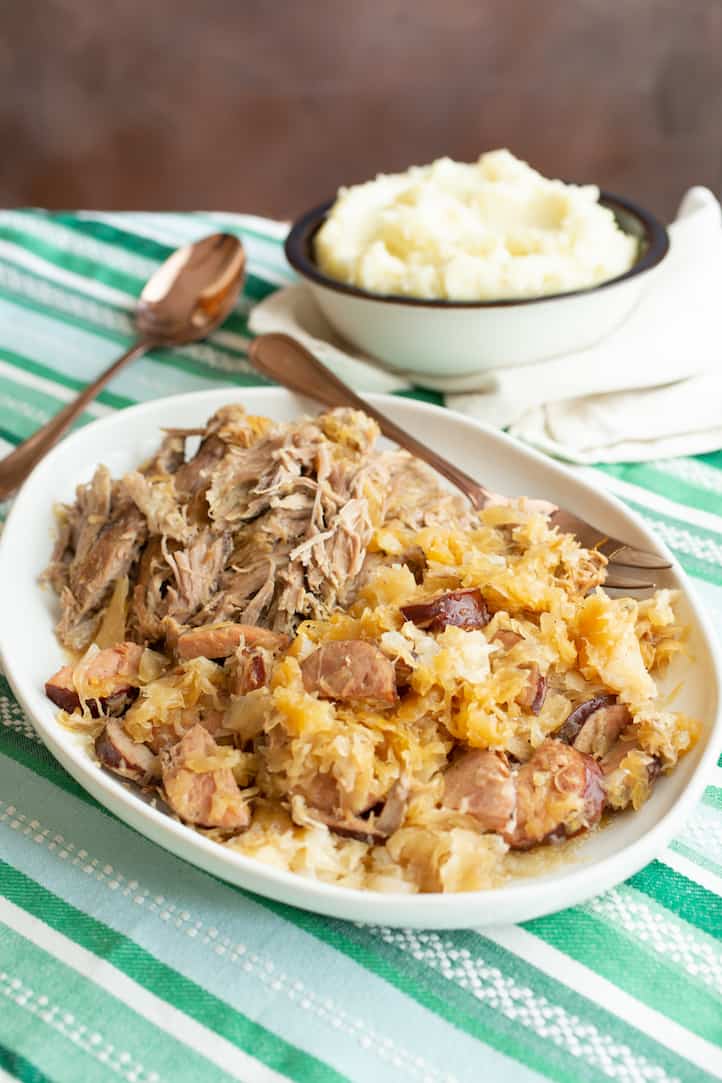
Ingredients:
- 3-4 lb pork roast (shoulder or loin)
- 2 lbs sauerkraut, drained
- 1 large onion, sliced
- 1 apple, cored and sliced
- 1 cup beer or apple cider
- 1 tablespoon brown sugar
- 1 teaspoon caraway seeds
- Salt and pepper to taste
Instructions:
- Preheat your oven to 325°F (165°C).
- Season the pork roast with salt and pepper and place it in a large Dutch oven or roasting pan.
- In a large bowl, combine the sauerkraut, onion, apple, beer or cider, brown sugar, and caraway seeds.
- Pour the sauerkraut mixture over and around the pork roast.
- Cover the Dutch oven or roasting pan and bake for 3-4 hours, or until the pork is tender and cooked through.
- Serve the pork and sauerkraut with a side of mashed potatoes or dumplings.
This hearty and flavorful dish is a perfect comfort food for a cold winter evening. [6]
5. Sourdough Pizza
Making pizza at home is a fun and delicious activity for the whole family. Using a sourdough starter for your pizza crust will give it a chewy texture and a tangy flavor that is far superior to any store-bought crust.

Ingredients:
- 1 cup active sourdough starter
- 1 1/2 cups all-purpose flour
- 1/2 cup warm water
- 1 teaspoon salt
- 1 tablespoon olive oil
- Your favorite pizza toppings
Instructions:
- In a large bowl, combine the sourdough starter, flour, warm water, salt, and olive oil. Mix until a shaggy dough forms.
- Knead the dough for 5-7 minutes, until it is smooth and elastic.
- Place the dough in a lightly oiled bowl, cover, and let it rise for 4-6 hours, or until doubled in size.
- Preheat your oven to 500°F (260°C) with a pizza stone or baking sheet inside.
- Gently stretch the dough into a 12-inch circle.
- Top with your favorite pizza sauce, cheese, and toppings.
- Carefully transfer the pizza to the preheated pizza stone or baking sheet.
- Bake for 10-12 minutes, or until the crust is golden brown and the cheese is bubbly.
This homemade sourdough pizza is a delicious and healthy alternative to takeout. [7]
6. Stir-fry with Fermented Black Bean Sauce
Fermented black bean sauce, also known as douchi, is a savory and pungent condiment that is widely used in Chinese cuisine. It adds a deep umami flavor to stir-fries and other dishes.
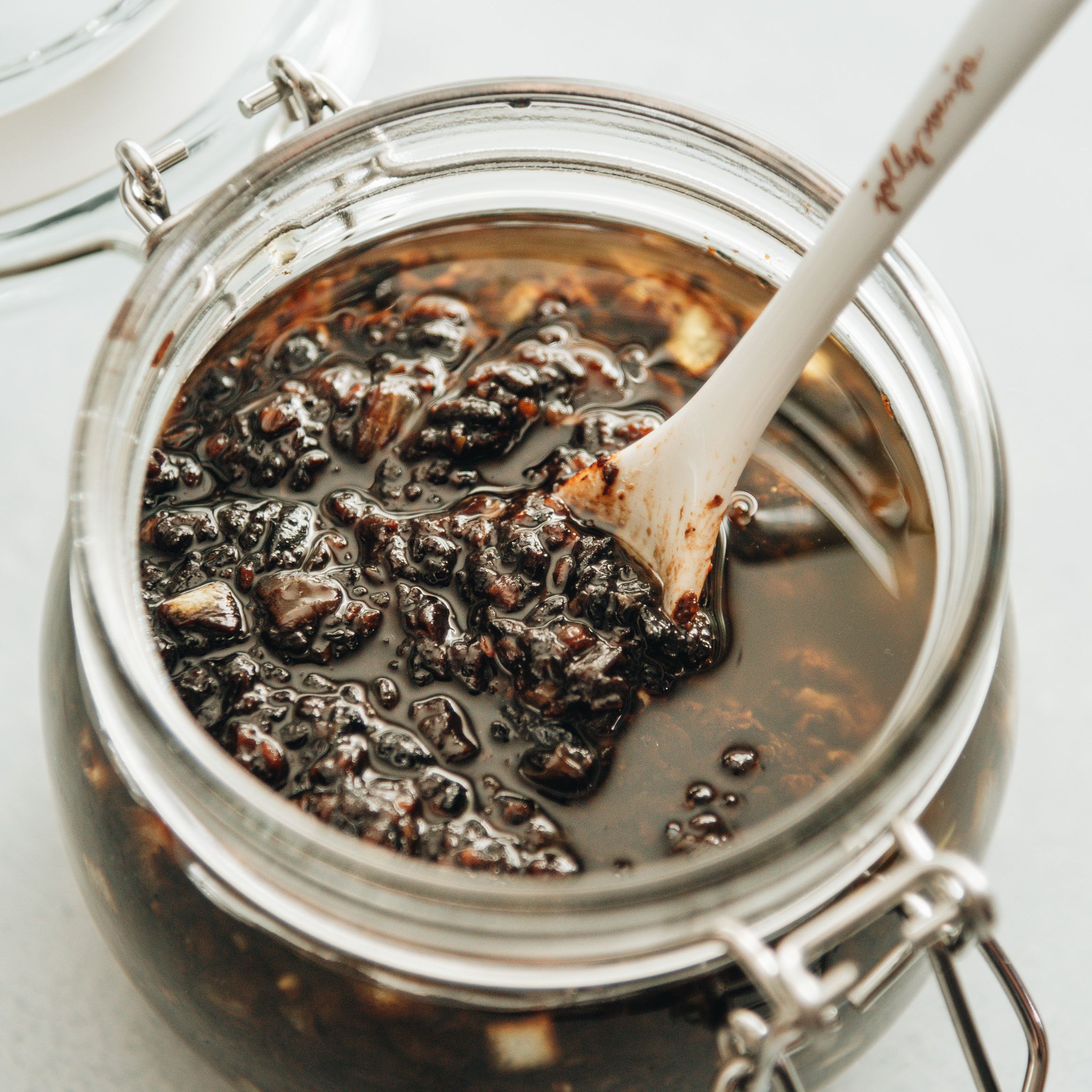
Ingredients:
- 1 lb chicken, beef, or tofu, cut into bite-sized pieces
- 1 tablespoon vegetable oil
- 2 cloves garlic, minced
- 1 tablespoon fermented black beans, rinsed and lightly mashed
- 1 tablespoon soy sauce
- 1 teaspoon sugar
- 1/2 cup chicken or vegetable broth
- Assorted vegetables (e.g., bell peppers, onions, broccoli)
Instructions:
- In a large skillet or wok, heat the vegetable oil over medium-high heat.
- Add the chicken, beef, or tofu and cook until browned.
- Add the garlic and fermented black beans and stir-fry for 1 minute, until fragrant.
- Stir in the soy sauce, sugar, and broth. Bring to a simmer.
- Add the assorted vegetables and cook for 5-7 minutes, until tender-crisp.
- Serve the stir-fry with a side of steamed rice.
This flavorful stir-fry is a great way to explore the bold flavors of fermented black beans. [8]
7. Fermented Vegetable Curry
Adding fermented vegetables to your curry is a great way to boost its flavor and nutritional value. The tangy and slightly sour taste of the fermented vegetables complements the rich and spicy flavors of the curry.
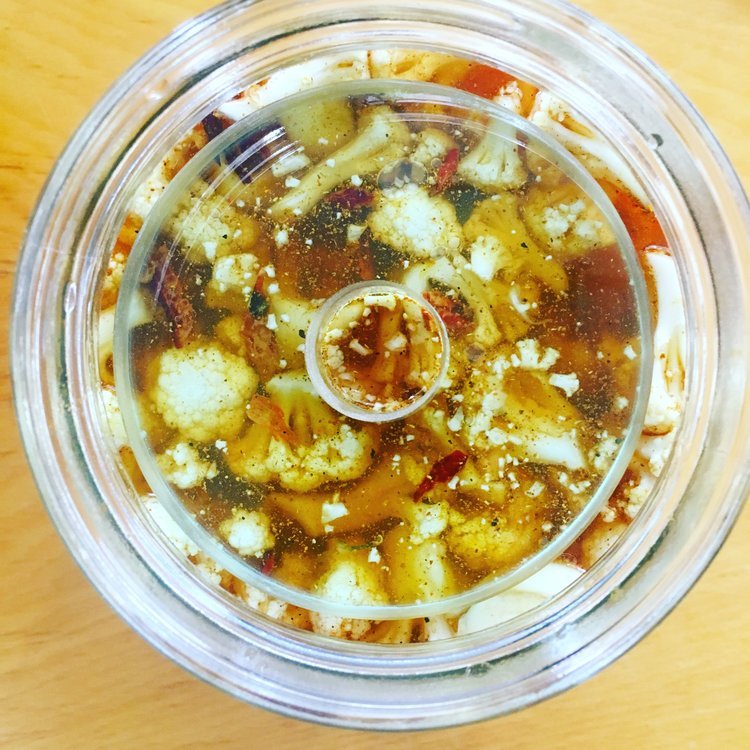
Ingredients:
- 1 tablespoon coconut oil
- 1 onion, chopped
- 2 cloves garlic, minced
- 1 tablespoon grated ginger
- 2 tablespoons curry powder
- 1 can (13.5 oz) coconut milk
- 1 cup vegetable broth
- 2 cups mixed vegetables (e.g., potatoes, carrots, peas)
- 1 cup fermented vegetables (e.g., sauerkraut, kimchi)
- Cooked rice for serving
Instructions:
- In a large pot or Dutch oven, heat the coconut oil over medium heat.
- Add the onion, garlic, and ginger and cook until fragrant.
- Stir in the curry powder and cook for 1 minute more.
- Add the coconut milk, vegetable broth, and mixed vegetables. Bring to a simmer and cook for 15-20 minutes, until the vegetables are tender.
- Stir in the fermented vegetables and cook for another 2-3 minutes, until heated through.
- Serve the curry over cooked rice.
This flavorful and aromatic curry is a delicious way to incorporate fermented vegetables into your dinner. [9]
8. Kefir Marinated Chicken
Kefir is not just for smoothies! Its tart and tangy flavor makes it a great marinade for chicken, helping to tenderize the meat and add a delicious flavor.

Ingredients:
- 1 lb boneless, skinless chicken breasts
- 1 cup plain kefir
- 2 cloves garlic, minced
- 1 tablespoon lemon juice
- 1 teaspoon dried oregano
- Salt and pepper to taste
Instructions:
- In a large bowl, whisk together the kefir, garlic, lemon juice, oregano, salt, and pepper.
- Add the chicken breasts to the marinade and make sure they are fully coated.
- Cover the bowl and refrigerate for at least 1 hour, or up to 4 hours.
- Preheat your grill or a skillet over medium-high heat.
- Remove the chicken from the marinade and grill or pan-sear for 6-8 minutes per side, or until cooked through.
- Serve the chicken with a side of roasted vegetables or a salad.
This simple and healthy marinade is a great way to add flavor and probiotics to your chicken dinner. [10]
9. Fermented Fish with Potatoes and Onions
Fermented fish is a traditional dish in many cultures, and it has a unique and pungent flavor that is not for the faint of heart. However, if you are feeling adventurous, it can be a delicious and nutritious meal.

Ingredients:
- 1 lb fermented fish (such as rakfisk or surströmming)
- 4 medium potatoes, boiled and sliced
- 1 large onion, thinly sliced
- Flatbread or lefse for serving
- Sour cream and butter for serving
Instructions:
- Prepare the fermented fish according to the package directions. This may involve rinsing it or soaking it in water.
- Arrange the sliced potatoes and onions on a platter.
- Place the fermented fish on top of the potatoes and onions.
- Serve with flatbread or lefse, sour cream, and butter.
This traditional dish is a unique culinary experience that is rich in probiotics and omega-3 fatty acids. [11]
10. Miso-Mushroom Pasta
This creamy and savory pasta dish gets its umami flavor from the addition of miso paste. It’s a quick and easy weeknight dinner that is both comforting and nutritious.
Ingredients:
- 8 oz pasta (such as fettuccine or spaghetti)
- 1 tablespoon olive oil
- 8 oz mushrooms, sliced
- 2 cloves garlic, minced
- 1/4 cup white miso paste
- 1/2 cup heavy cream or coconut cream
- 1/4 cup grated Parmesan cheese
- Salt and pepper to taste
Instructions:
- Cook the pasta according to package directions. Drain and set aside.
- In a large skillet, heat the olive oil over medium-high heat.
- Add the mushrooms and cook until they are browned and softened.
- Add the garlic and cook for 1 minute more, until fragrant.
- In a small bowl, whisk together the miso paste and heavy cream until smooth.
- Pour the miso cream sauce into the skillet with the mushrooms and bring to a simmer.
- Stir in the Parmesan cheese and season with salt and pepper to taste.
- Add the cooked pasta to the skillet and toss to coat.
- Serve immediately with a sprinkle of extra Parmesan cheese.
This rich and flavorful pasta is a delicious way to incorporate the benefits of miso into your dinner. [12]





